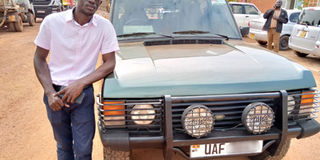I do minor repairs for my 33-year-old car - Kakembo

Kakembo says although he spent some money to restore the car, it was worth it. Photos by Roland d. Nasasira
What you need to know:
Haroon Kakembo says he cannot exchange his car for any other because of its capability on and off the road. He says he can travel long distances with his family and can do some minor repairs himself.
Haroon Kakembo describes his army green Range Rover Classic as a car of all seasons regardless of how old it becomes. It is one of the thousands of other classics that were manufactured by the Land Rover brand between 1970 and 1996, a period under which the first generation of vehicles produced under the Range Rover name were on market.
Manufactured in 1986, Kakembo’s Range Rover Classic runs on a 2500cc TDI (Turbocharged Direct Injection) diesel engine and belongs to the Sport Utility Vehicle (SUV) category. It comes with four doors and is a five seater SUV.
“Initially, I had to rebuild the car myself. When I acquired it in late 2018, it had a 3,900cc petrol engine that I had to change. It cost me Shs18m to import a used engine and other parts from the UK.
When you are undertaking a car engine replacement, key and sensitive car parts such as the radiator also change. When I eventually got it on the road, it was worth the money because I can drive this car on a daily basis anywhere without minding about its consumption,” Kakembo starts.
In the interior, Kakembo also changed the car seats. The ones it initially had were really worn out, thus the need to source for the current soft cloth coated seats from another car that was no longer in use.
General specifications
On both tarmac and murram terrains, Kakembo says the Range Rover Classic uses one litre of fuel to cover a distance of 10 kilometres. But initially with the petrol engine, it could cover approximately 15 kilometres using one litre.
“Feeling the depth or effect of potholes or humps while driving this car on any road terrain depends on the amount of tyre pressure. If you have the required one, you will not feel the discomfort of humps and potholes. It also depends on the suspension system. As I rebuilt the car, I also had to change the suspension system so that I enjoy more driving comfort and not be affected by potholes,” Kakembo observes.
Away from the suspension system and engine changing, Kakembo also had to redo the body colour. The initial colour was still green but pale, yet Kakembo says he needed one that was shinny to make his car appear modern. “I engaged a professional car colour painter and mixer to come up with the best green colour fit for a Range Rover Classic,” he says.
Performance specifications
Once you step on the accelerator when the car is parked, it picks up speed from zero to 100km/hour in a space of 13 seconds.
The Classic also has a maximum speed of 140km/hour, which differs from the initial 3,900cc petrol engine the car had where it could pick up speed from zero to 100km/hour is 10.7seconds.
Safety features
According to Kakembo, his 1986 model does not have the antilock brake system (ABS) and airbags but has all the other features such as seatbelts still intact.
Comparison
The Range Rover Classic was a base model that did not have variations of similar cars in the same category such as the Range Rover Vogue, Range Rover Evoque or Range Rover Sport. This makes the Classic only comparable to the Range Rover Vogue that has newer technology, air suspension, features that the old model Range Rover classic does not have.
“I would like the pride of driving the Range Rover Classic but I would not trade it for the Vogue. If I experience any breakdown on the road, I can easily understand what went wrong and fix it myself. With the newer version Range Rover Vogue, you have to find a mechanic with a computer to diagnose the problem because it is highly computerised,” Kakembo says.

The interior of Kakembo’s car is spacious even for the tallest driver or passenger.
To Kakembo, computers show a failing car part but at times, the error messages are ambiguous that you cannot tell that a particular part is failing. A diagnosing computer could show that a fuse has blown but will not tell you what the cause was.
Cost
According to Ronnie William Kyazze, a Range Rover enthusiast, the last Range Rover Classic was manufactured in 1996. This means that you can only acquire one from a motorist who is selling or probably one that is in the junkyard and restore it.
However, on average, it will cost you between Shs20m to Shs50m or more depending on what is in or on the car. This is because different Range Rover Classic owners use different parts to keep their cars in the best roadworthy condition.




